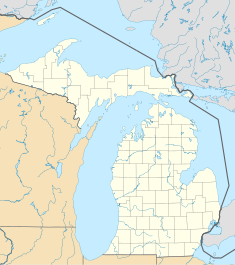| This article relies excessively on references to primary sources. Please improve this article by adding secondary or tertiary sources. Find sources: "Trinity Episcopal Church" Houghton, Michigan – news · newspapers · books · scholar · JSTOR (January 2012) (Learn how and when to remove this message) |
| Some of this article's listed sources may not be reliable. Please help improve this article by looking for better, more reliable sources. Unreliable citations may be challenged and removed. (January 2012) (Learn how and when to remove this message) |
| Trinity Episcopal Church | |
|---|---|
 Church in March 2012 Church in March 2012 | |
| Location | 205 East Montezuma Avenue Houghton, Michigan |
| Coordinates | 47°07′16″N 88°34′16″W / 47.121°N 88.571°W / 47.121; -88.571 |
| Built | 1906-1910 |
| Architect | John Sutcliffe |
| Architectural style(s) | Gothic Revival |
| Governing body | Private |
| Michigan State Historic Site | |
| Designated | July 17, 1986 |
 | |
Trinity Episcopal Church is a Gothic Revival-style Episcopal church at 205 East Montezuma Avenue in Houghton, Michigan. It was designated a Michigan State Historic Site on July 17, 1986. It is the second of two church buildings to exist on the site; the current one replaced a wooden structure in 1910. The church's philosophy is built on the Oxford Movement.
History
The parish was founded on July 17, 1860, when the Episcopal Bishop of Michigan, Reverend Samuel A. McCoskry, met with nine businessmen from Houghton and Hancock. The first clergyman sent to serve the church, upon arriving in Houghton on a Saturday, immediately departed on the vessel that had carried him. Public services were first held on September 15, 1860. The name Trinity Church was chosen at the first vestry meeting, held on July 13, 1861.
The church's first permanent home was a wooden building across the Portage Canal in Hancock, built on land donated by the Quincy Mining Company. However, it was soon decided that the structure would be moved to Houghton, on land owned by Shelden, a member of the church. The church was placed on a barge overnight, but it came free of its bounds and was found floating free in the morning. It was successfully recovered and transferred to Houghton, where it remained until 1910.
The wooden church was demolished in early 1910 to make way for the current church, built of brick and Jacobsville Sandstone, which was completed on Easter that same year. In 1995, a two-story addition was built to house the pastor's office. The current church was designated a Michigan State Historic Site on July 17, 1986, and an informational marker was erected on April 24, 1987.
Architecture

The church is a brick structure built in the Gothic Revival style. The basement façade, copings, and trim are all made of Jacobsville Sandstone. The building has a square tower at one corner capped with crenellations.
The building architect was John B. Sutcliffe and interior artwork and carvings were done by Alois Lang. The interior design of the church was influenced by the Oxford Movement. The roof's wooden trusses are exposed as arches that span the nave. The church houses an Austin Organ, opus 419, which was installed in 1913.
See also
Notes
- ^ The address is 200 Pewabic Street in the Michigan State Historic Site listing.
- His name is spelled McCrosky in the Michigan State Historic Site listing.
References
- ^ Staff. "Trinity Episcopal Church". State Historic Preservation Office. Michigan State Housing Development Authority. Archived from the original on January 2, 2014. Retrieved January 7, 2012.
- "Home". Trinity Episcopal Church Houghton. Retrieved January 7, 2012.
- ^ Neese, Garrett (August 7, 2010). "Trinity Episcopal Church celebrates 150th anniversary". The Daily Mining Gazette. Archived from the original on March 4, 2016. Retrieved January 7, 2012.
- ^ "History of Trinity Episcopal Church". Trinity Episcopal Church Houghton. Retrieved January 7, 2012.
- "Austin organ at Trinity Episcopal Church". Trinity Episcopal Church Houghton. Archived from the original on May 9, 2008. Retrieved January 7, 2012.
- Staff (January 14, 2012). "Recital Features Performance on Historic Church Organ". The Daily Mining Gazette.